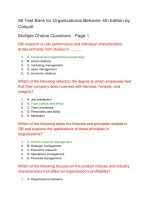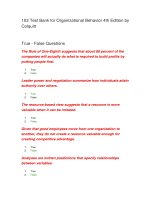Organizational behavior 4th by MShean chap015
Bạn đang xem bản rút gọn của tài liệu. Xem và tải ngay bản đầy đủ của tài liệu tại đây (466.88 KB, 34 trang )
15
Organizational
Structure
McGraw-Hill/Irwin
© 2008 The McGraw-Hill Companies, Inc. All rights reserved.
Nitro’s Structural Advantage
Courtesy of Nitro Group
Boutique advertising firm Nitro relies on an organizational
structure that keeps it nimble and responsive to customer
needs. Founded in Shanghai, Nitro is a virtual global
agency in which each local office has account service staff,
but a global creative swat team is parachuted in as
required.
McShane/Von Glinow OB4e
Slide 15-2
© 2008 The McGraw-Hill Companies, Inc. All rights reserved.
Division of Labor
Courtesy of Nitro Group
Subdivision of work into separate jobs assigned
to different people
Potentially increases work efficiency
Necessary as company grows and work
becomes more complex
McShane/Von Glinow OB4e
Slide 15-3
© 2008 The McGraw-Hill Companies, Inc. All rights reserved.
Forms of Work Coordination
• Informal communication
– Sharing information
– High media-richness
– Important in teams
– Integrator roles in larger firms
• Formal hierarchy
– Direct supervision
– Common in larger firms
– Problems -- costly, slow, less popular today with workforce
• Standardization
– Processes -- formal instructions
– Outputs -- clear goals/output measures
– Skills -- training, learn precise role behaviors
McShane/Von Glinow OB4e
Slide 15-4
© 2008 The McGraw-Hill Companies, Inc. All rights reserved.
Elements of Organizational Structure
Departmentalization
Span of
Control
Organizational
Structure
Elements
Formalization
McShane/Von Glinow OB4e
Centralization
Slide 15-5
© 2008 The McGraw-Hill Companies, Inc. All rights reserved.
Span of Control
• Number of people
directly reporting to the
next level
– Assumes coordination
through direct supervision
• Wider span of control
possible with other
coordinating
mechanisms present
McShane/Von Glinow OB4e
Slide 15-6
© 2008 The McGraw-Hill Companies, Inc. All rights reserved.
Trend Toward Flatter Structures
• Firms moving toward
flatter structures
– Cuts costs
– Puts decision makers closer
to front-line information
– Supports empowerment
• Problem: risk of cutting too
much middle management
McShane/Von Glinow OB4e
Slide 15-7
© 2008 The McGraw-Hill Companies, Inc. All rights reserved.
Centralization and Decentralization
Centralization
Formal decision making authority is held
by a few people, usually at the top
Decision making authority is
dispersed throughout the organization
Decentralization
McShane/Von Glinow OB4e
Slide 15-8
© 2008 The McGraw-Hill Companies, Inc. All rights reserved.
Formalization
• The degree to which organizations standardize
behavior through rules, procedures, formal training,
and related mechanisms.
• Formalization increases as firms get older, larger, and
more regulated
• Problems
–
–
–
–
Reduces organizational flexibility
Work rules can undermine productivity
Employees feel disempowered
Rules become focus of attention
McShane/Von Glinow OB4e
Slide 15-9
© 2008 The McGraw-Hill Companies, Inc. All rights reserved.
Mechanistic vs. Organic Structures
Organic
Mechanistic
• Narrow span of control
• Wide span of control
• High formalization
• Little formalization
• High centralization
• Decentralized decisions
McShane/Von Glinow OB4e
Slide 15-10
© 2008 The McGraw-Hill Companies, Inc. All rights reserved.
Effects of Departmentalization
1. Establishes chain of command (supervision
structure)
2. Creates common mental models, measures
of performance, etc
3. Encourages staff to coordinate through
informal communication
McShane/Von Glinow OB4e
Slide 15-11
© 2008 The McGraw-Hill Companies, Inc. All rights reserved.
Features of Simple Structures
• Minimal hierarchy -- staff reports directly to
owner
• Roles are fairly loosely defined for flexibility
• Informal communication for coordination
• Centralized structure -- owner makes most
decisions
McShane/Von Glinow OB4e
Slide 15-12
© 2008 The McGraw-Hill Companies, Inc. All rights reserved.
Functional Organizational Structure
Organizes employees around specific
knowledge or other resources
(marketing, production)
CEO
Finance
McShane/Von Glinow OB4e
Production
Slide 15-13
Marketing
© 2008 The McGraw-Hill Companies, Inc. All rights reserved.
Evaluating Functional Structures
• Benefits
– Supports professional identity and career paths
– Permits greater specialization
– Easier supervision --similar issues
– Creates an economy of scale --common pool of talent
• Limitations
– More emphasis on subunit than organizational goals
– Higher dysfunctional conflict
– Poorer coordination -- requires more controls
McShane/Von Glinow OB4e
Slide 15-14
© 2008 The McGraw-Hill Companies, Inc. All rights reserved.
Divisional Structure
Organizes employees around outputs,
clients, or geographic areas
CEO
Consumer
Products
McShane/Von Glinow OB4e
Lighting
Products
Slide 15-15
Medical
Systems
© 2008 The McGraw-Hill Companies, Inc. All rights reserved.
Evaluating Divisional Structures
• Benefits
– Building block structure -- accommodates growth
– Better coordination in diverse markets
• Limitations
– Duplication, inefficient use of resources
– Specializations are dispersed, creating silos of knowledge
– Difficult to determine which divisional structure should have
priority
McShane/Von Glinow OB4e
Slide 15-16
© 2008 The McGraw-Hill Companies, Inc. All rights reserved.
Bioware’s Matrix Structure
Ray Muzyka (left) and Greg
Zeschuk (right) adopted a
matrix organizational structure
for their electronic games
company, Bioware, because it
balances the need for
teamwork and information
sharing.
Ed Kaiser/Edmonton Journal
McShane/Von Glinow OB4e
Slide 15-17
© 2008 The McGraw-Hill Companies, Inc. All rights reserved.
Matrix Structure (Project-based)
Employees ( ) are temporarily assigned to a specific
project team and have a permanent functional unit
CEO
Engineering
Marketing
Design
Project A
Manager
Project B
Manager
Project C
Manager
McShane/Von Glinow OB4e
Slide 15-18
© 2008 The McGraw-Hill Companies, Inc. All rights reserved.
Evaluating Matrix Structures
• Benefits
–
–
–
–
Uses resources and expertise effectively
Improves communication,flexibility, innovation
Focuses specialists on clients and products
Supports knowledge sharing within specialty across
groups
– Solution when two divisions have equal importance
• Limitations
– Increases goal conflict and ambiguity
– Two bosses dilutes accountability
– More conflict, organizational politics, and stress
McShane/Von Glinow OB4e
Slide 15-19
© 2008 The McGraw-Hill Companies, Inc. All rights reserved.
W. L. Gore’s Team-Based Structure
W. L. Gore & Associates Inc.
has an extreme team-based
organizational structure that
eliminates the traditional
hierarchy. Associates are
organized around self-directed
teams at dozens of
manufacturing and sales
offices around the world.
© Bill Kramer/ Bill Kramer Photography Inc.
McShane/Von Glinow OB4e
Slide 15-20
© 2008 The McGraw-Hill Companies, Inc. All rights reserved.
Team-Based Structure Features
• Self-directed work teams
• Teams organized around work
processes
• Very flat hierarchy, few
management levels
• Very little formalization
• Usually found within
divisionalized structure
© Bill Kramer/ Bill Kramer Photography Inc.
McShane/Von Glinow OB4e
Slide 15-21
© 2008 The McGraw-Hill Companies, Inc. All rights reserved.
Evaluating Team-Based Structures
• Benefits
– Responsive, flexible
– Lower admin costs
– More informed decisions
• Limitations
–
–
–
–
Interpersonal training costs
Slower during team development
Stress due to ambiguous roles
Problems with supervisor role
changes
© Bill Kramer/ Bill Kramer Photography Inc.
McShane/Von Glinow OB4e
Slide 15-22
© 2008 The McGraw-Hill Companies, Inc. All rights reserved.
Network Organizational Structure
Product
developmen
t partner
(U.S.A.)
Call center
partner
(India)
Core
Firm
Package
design
partner
(UK)
Accounting
partner
(Canada)
Assembly
partner
(Mexico)
McShane/Von Glinow OB4e
Slide 15-23
© 2008 The McGraw-Hill Companies, Inc. All rights reserved.
Network Structure v. Virtual Corp.
• Network structure
– An alliance of several organizations for the purpose of
creating a product or serving a client
• Virtual corporation
– Several independent companies that form unique
partnership teams to provide customized products or
services, usually to specific clients, for a limited time
McShane/Von Glinow OB4e
Slide 15-24
© 2008 The McGraw-Hill Companies, Inc. All rights reserved.
Evaluating Network Structures
• Benefits
– Highly organic -- flexible design
– Efficiencies from acquiring and discarding
resources as needed from partnerships
• Limitations
– Exposes core firm to market forces -- shortages of
facilities and talent
– Less control over non-core work processes
McShane/Von Glinow OB4e
Slide 15-25
© 2008 The McGraw-Hill Companies, Inc. All rights reserved.









